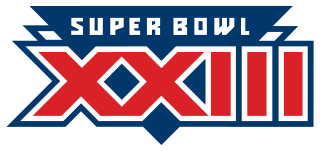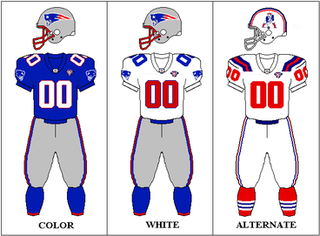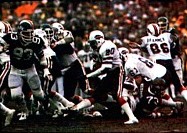| No. 88 | |
|---|---|
| Position: | Tight end |
| Personal information | |
| Born: | August 5, 1946 Oakdale, California, U.S. |
| Height: | 6 ft 4 in (1.93 m) |
| Weight: | 227 lb (103 kg) |
| Career information | |
| College: | Pacific (CA) |
| Undrafted: | 1969 |
| Career history | |
| As a player: | |
| As a coach: | |
| |
| Head coaching record | |
| Regular season: | 47–77 (.379) |
| Postseason: | 0–1 (.000) |
| Career: | 47–78 (.376) |
| Player stats at PFR | |
| Coaching stats at PFR | |
Bruce Coslet (born August 5, 1946) is a former American college and professional football player and professional football coach. A tight end, he played for the University of the Pacific and in 1969 debuted with the American Football League (AFL)'s Cincinnati Bengals. He played for the Bengals in the National Football League (NFL) through 1976. [1]
Coslet was born in Oakdale, California and graduated from Oakdale High School. He played college football at the University of the Pacific before playing for the Cincinnati Bengals from 1969 to 1976. [2]
Coslet was named the offensive coordinator for the Bengals in 1986 under head coach Sam Wyche. In his first year in the position Cincinnati's offense ranked first in the league in total yards and third in total points scored, and the Bengals finished the season with a 10–6 record. It was not enough, however, for the team to make the playoffs as they were one of four teams in the AFC that finished 10-6 and did not have any tiebreakers favoring them. In 1987 the Bengals ranked fifth in total yards under Coslet, but failed to score many points and finished the season with a 4–11 record.
The Bengals' best was yet to come, however, and Coslet's offensive unit finished with the top scoring and top yardage producing offense in 1988. It helped the Bengals finish 12-4 and reach the Super Bowl, only for them to lose to the San Francisco 49ers. Although Cincinnati failed to return to the playoffs in 1989, Coslet's unit was again in the top five in the league as they scored the fourth most points and produced the third most total yards in the NFL.
With his successes as an assistant, Coslet found himself highly sought after as a head coach and was hired by the New York Jets for the 1990 season.
Coslet took over a Jets team that had finished 4-12 under Joe Walton the year before and improved the team's fortunes slightly. The Jets were hovering around .500 for the first half of the season, but a five-game losing streak took away any hope of that. The Jets finished 6–10, winning their last two games of the year against the New England Patriots and the Tampa Bay Buccaneers.
In 1991, the Jets did not start out particularly well as, after an opening week win against Tampa Bay, the team dropped their next three games. Coslet led the team to six wins in their next eight games, putting the Jets into playoff contention at 7–5. After losing their next three games, however, the Jets were left at 7–8. Still, the Jets were in control of their own playoff destiny as a win in Week 17 would ensure a Wild Card berth. The Jets knocked off the Miami Dolphins on the road in the finale, giving Coslet his first playoff berth as a head coach. Their matchup in the wild-card round was against the Houston Oilers, which they lost.
Coslet's 1992 team was decimated by injuries and hampered by ineffective coaching by Coslet thereby not doing any favors for the new starting quarterback Browning Nagle, who was named the starter after longtime veteran starter Ken O'Brien held out for most of the first half of the season. Two of the injuries proved to be career ending. In Week 10 against the Denver Broncos, star receiver Al Toon suffered the ninth concussion of his career and was forced to retire after the game. Then, in Week 13 against the Kansas City Chiefs, a collision between defensive ends Scott Mersereau and Dennis Byrd left Byrd with a broken neck and temporarily paralyzed. Although the Jets finished 4–12, two of the wins came against AFC East division champion Miami and the eventual AFC champion Buffalo Bills.
The Jets retained Coslet for 1993, and even made an effort to upgrade the quarterback position by trading for veteran Boomer Esiason, whom Coslet had coached during his time in Cincinnati. However, he was given a clear directive by management: if the Jets did not make the playoffs in 1993, Coslet would be fired at the end of the season regardless of the team's record. Things did not start off well, as after the first six games the Jets were 2-4 and entering a Halloween matchup with their in-stadium rivals, the 5-1 Giants. The Jets managed to pull off an upset, defeating the Giants 10–6, and carried that momentum to victories in their next four games, capped off by a 6–0 win against the rival Patriots to get to 7–4.
After that, however, the Jets’ fortunes changed drastically. Their winning streak was broken by the lowly Indianapolis Colts, who had only recorded three wins and had lost seven of their previous eight games. The Jets then traveled to Washington to face the struggling Redskins, who had also only won three games, but only managed to eke out a 3–0 win. A 28-7 blowout loss to the defending world champion Dallas Cowboys at home followed, and after a 16–14 loss in Buffalo the Jets were left with a must-win game in Week 18 against the Houston Oilers. The Oilers had entered the game on a ten-game winning streak and had not lost a game in the Astrodome all season; the overmatched Jets lost 24-0 and Coslet was fired the next day.
In 1994 Coslet returned to the Bengals, who were now coached by Dave Shula, and retook his offensive coordinator position. Cincinnati was not the same place that Coslet had left, as the team was now one of the most consistently losing teams in the league. In his first two years as coordinator Coslet's offensive unit hovered around the middle of the league in yards and points scored while the Bengals won a combined 10 games. The team did start to show some bright spots on offense, beginning with a change in philosophy. After seven games the Bengals finally gave up on disappointing first round draft pick David Klingler and benched him in favor of Jeff Blake, whom the team had signed away from the Jets where Coslet had coached him. The change paid dividends immediately and Blake nearly beat the two-time defending Super Bowl champion Dallas Cowboys in his first start. Blake developed a rapport with young wide receivers Carl Pickens and Darnay Scott, who were his two main targets, and Coslet's playcalling used that to the team's advantage.
In Coslet's first season back, Pickens had over 1,000 yards receiving on 71 catches and the rookie Scott added 866 on 46 receptions; by comparison, the 1993 Bengals saw no receiver record more than 56 catches or 654 yards (both done by receiver Jeff Query, who only recorded five catches in the new system). Coslet's offensive unit improved somewhat in 1995, as Blake threw for over 3,800 yards and made the Pro Bowl while Pickens recorded 17 receiving touchdowns and 1,234 yards to join Blake. Scott recorded 821 yards, and tight end Tony McGee caught 55 passes for 754 yards. Although the yardage was not there, Coslet's offense finished fourth in the league in total touchdowns with 29.
After a 1–6 start to the 1996 season, Shula announced his resignation and Coslet was promoted to the head coaching position. Although the Bengals once again failed to make the playoffs, Coslet led the team to a 7-2 finish and the offensive unit was back in the NFL's top 10. Pickens and Scott again proved to be an effective 1-2 combination, as Pickens caught 100 passes and topped 1,000 yards for the third straight year while Scott added 58 catches for 833 yards. Blake threw for 3,624 yards, but it was not good enough to make the Pro Bowl; Pickens was the offense's only representative.
Although Coslet saw the team take a slight step backward, finishing at 7–9 in 1997, the offense again finished in the top ten in points scored and total yards. Most of that was due to the re-emergence of Boomer Esiason, who the Bengals reacquired in the offseason and who replaced a largely ineffective Blake with five games left in the season. Esiason won four of those starts, with his only loss coming in a game against the Philadelphia Eagles where he threw four touchdown passes only to be beat on a late field goal. Esiason threw 13 touchdown passes against two interceptions in his limited action. Although Scott and Pickens' receiving statistics went down considerably- Scott led the team with 54 catches and 797 yards, while Pickens only managed 52 catches in 695 yards while missing four games- the offense found a new star in emerging rookie running back Corey Dillon, who amassed over 1,100 yards despite only making six total starts.
The 1998 Bengals took a nosedive, finishing at 3–13. Coslet elected to give the starting job to veteran Neil O'Donnell, who had just been released from a multimillion-dollar long-term deal he'd signed with the Jets prior to the 1996 season. O'Donnell, Blake, Paul Justin and Eric Kresser all saw action as starting quarterback that year, with O'Donnell leading the team in wins with just two. Despite this, Pickens returned to form leading the team in catches and yards while Scott led the team with seven touchdowns. Dillon became the full-time starting halfback and rushed for 1,100 yards again.
Coslet's 1999 team did little better, and started out by losing ten of its first eleven games. Blake was once again the starter for most of the year, with rookie Akili Smith getting four starts. Blake managed to throw for 2,670 yards and 16 touchdowns despite only winning three of his starts, while Smith showed the struggles that would come to define his career by only throwing two touchdowns versus six interceptions. Although the offense struggled, Dillon again topped a thousand yards by rushing for exactly 1,200 [lower-alpha 1] and Scott topped 1,000 receiving yards and led the team in catches, yards, and touchdowns. Pickens could only manage 57 catches for 737 yards. In addition, Pickens was highly critical of Coslet toward the end of the season, and denounced the team for keeping him on despite the last two seasons.
In the 1999 offseason, the Bengals decided to overhaul their roster. Blake was allowed to leave in free agency and signed with the New Orleans Saints. Pickens was released and played out his final season with the Tennessee Titans. Scott did not play at all in the 2000 season, and Smith was named the starter. The focus of the offense was to be on Dillon, Scott, and highly touted #1 draft pick Peter Warrick. However, Coslet saw his team struggle in their first game as a unit against the newly reformed Cleveland Browns and lost 24–7. The next week, the Jacksonville Jaguars shut out Coslet's team 14–0. After their third consecutive loss, this one a 37-0 blowout against the eventual Super Bowl Champion Baltimore Ravens, Coslet resigned the next day out of frustration and handed control of the team to defensive coordinator Dick LeBeau.
After a year off, Coslet was hired by Cowboys head coach Dave Campo to serve as his offensive coordinator. Coslet's unit ranked near the bottom of the league in both points scored and total yards. Under Coslet, Emmitt Smith saw his streak of 1,000 yard seasons broken at eleven despite his setting of the NFL's all-time rushing yardage record. Smith also only managed five rushing touchdowns, two off his career low. Neither of his starting quarterbacks, Chad Hutchinson or Quincy Carter, were effective either. After a 5-11 finish, the third straight under Campo, Bill Parcells was hired as head coach and Coslet was not retained. He has not held a coaching position since.
Coslet is a member of The Delta Upsilon fraternity. [4]
| Team | Year | Regular Season | Post Season | |||||||
|---|---|---|---|---|---|---|---|---|---|---|
| Won | Lost | Ties | Win % | Finish | Won | Lost | Win % | Result | ||
| NYJ | 1990 | 6 | 10 | 0 | .375 | 4th in AFC East | - | - | - | |
| NYJ | 1991 | 8 | 8 | 0 | .500 | 2nd in AFC East | 0 | 1 | .000 | Lost to the Houston Oilers in AFC Wild Card Playoff Game |
| NYJ | 1992 | 4 | 12 | 0 | .250 | 4th in AFC East | - | - | - | |
| NYJ | 1993 | 8 | 8 | 0 | .500 | 3rd in AFC East | - | - | - | |
| NYJ Total | 26 | 38 | 0 | .406 | 0 | 1 | .000 | |||
| CIN | 1996 | 7 | 2 | 0 | .778 | 3rd in AFC Central | - | - | - | |
| CIN | 1997 | 7 | 9 | 0 | .438 | 4th in AFC Central | - | - | - | |
| CIN | 1998 | 3 | 13 | 0 | .188 | 5th in AFC Central | - | - | - | |
| CIN | 1999 | 4 | 12 | 0 | .250 | 5th in AFC Central | - | - | - | |
| CIN | 2000 | 0 | 3 | 0 | .000 | 5th in AFC Central | - | - | - | |
| CIN Total | 21 | 39 | 0 | .350 | - | - | - | |||
| Total | 47 | 77 | 0 | .379 | 0 | 1 | .000 | |||

Super Bowl XXIII was an American football game between the American Football Conference (AFC) champion Cincinnati Bengals and the National Football Conference (NFC) champion San Francisco 49ers to decide the National Football League (NFL) champion for the 1988 season. The 49ers defeated the Bengals 20–16, winning their third Super Bowl. The game was played on January 22, 1989, at Joe Robbie Stadium in Miami. This was the first Super Bowl hosted in the Miami area in 10 years, and the first in Miami not held at the Orange Bowl.

Norman Julius "Boomer" Esiason is an American former football quarterback who played in the National Football League (NFL) for 14 seasons, primarily with the Cincinnati Bengals. He played college football for the Maryland Terrapins and was selected in the second round of the 1984 NFL Draft by the Bengals, where he spent 10 non-consecutive seasons. Esiason was also a member of the New York Jets and Arizona Cardinals.
Corey James Dillon is an American former professional American football player who was a running back for 10 seasons in the National Football League (NFL) with the Cincinnati Bengals and New England Patriots. Dillon played college football for the Washington Huskies and was selected by the Bengals in the second round of the 1997 NFL draft.
Kenneth Allan Anderson is an American former professional football player who was a quarterback in the National Football League (NFL), spending his entire career with the Cincinnati Bengals. He later returned as a position coach.

Samuel David Wyche was an American football quarterback and coach. He was a quarterback and head coach for the Cincinnati Bengals and a quarterbacks coach for the San Francisco 49ers. As head coach, he led the Bengals to Super Bowl XXIII, which they lost to the 49ers 20–16, relinquishing the lead on a last-minute touchdown. He was also known for introducing the use of the no-huddle offense as a standard offense.
Jeffrey Bertrand Blake is an American former football quarterback who played in the National Football League (NFL) for 14 seasons. Blake was a member of seven teams during his career, playing his longest stint with the Cincinnati Bengals from 1994 to 1999. Prior to his five seasons in Cincinnati, he was selected in the sixth round of the 1992 NFL Draft by the New York Jets, who he was a member of for two seasons. He spent the second half of his career playing for the New Orleans Saints from 2000 to 2001 and one season each with the Baltimore Ravens, Arizona Cardinals, Philadelphia Eagles, and Chicago Bears.
Carl McNally Pickens is an American former professional football player who was a wide receiver in the National Football League (NFL) for the Cincinnati Bengals and Tennessee Titans. He played college football for the Tennessee Volunteers, earning first-team All-American honors in 1991.

The National Football League playoffs for the 1988 season began on December 24, 1988. The postseason tournament concluded with the San Francisco 49ers defeating the Cincinnati Bengals in Super Bowl XXIII, 20–16, on January 22, 1989, at Joe Robbie Stadium in Miami, Florida.
Darnay Scott is an American former professional football player who was a wide receiver in the National Football League (NFL) for the Cincinnati Bengals and Dallas Cowboys. He played college football for the San Diego State Aztecs.

Michael Brown is an American football executive who is the owner of the Cincinnati Bengals in the National Football League (NFL). The son of Bengals co-founder Paul Brown, he joined the Bengals upon their founding in 1968 and assumed ownership after his father's death in 1991. Before beginning his career as a football executive, he played quarterback at Dartmouth.

The Cincinnati Bengals are a professional football franchise in the National Football League. Since starting off as an expansion franchise in the American Football League in 1968, they have appeared in three Super Bowls, but lost all three times, twice to the San Francisco 49ers and once to the Los Angeles Rams.
Tony Lamont McGee is an American former professional football player who was a tight end in the National Football League (NFL) for the Cincinnati Bengals, Dallas Cowboys and New York Giants. He played college football for the Michigan Wolverines.

The 1994 New England Patriots season was the team's 35th season, and 25th in the National Football League (NFL). It was the first under owner Robert Kraft, who purchased the team after preventing previous owner James Orthwein from moving the Patriots to St. Louis. The Patriots finished the season with a record of ten wins and six losses, and finished tied for first in the AFC's East division.
The 1993 New York Jets season was the 34th season for the team and the 24th in the National Football League. After the team had returned from its 1991 playoff season with a 4–12 1992 campaign, the Jets and coach Bruce Coslet looked to get back into the postseason.
John Eric Kattus is a former professional American football tight end who played primarily for the Cincinnati Bengals of the National Football League (NFL). He also played briefly with the New York Jets of the NFL. Kattus played in college for the Michigan Wolverines football team where he served as captain of the team during the 1985 season. He was also a member of the 1982 Big Ten Conference Champions.
The 1988 Cincinnati Bengals season was the team's 21st year in professional football and its 19th with the National Football League (NFL).

The 1997 Cincinnati Bengals season was the team's 30th season in professional football and its 28th in the National Football League. After winning the first game of the season, the Bengals lost their next seven games to effectively end any playoff hopes. The struggles cost Jeff Blake his starting quarterback job, as former Bengal starting quarterback Boomer Esiason, who was reacquired in the off-season, came back in to lead the Bengals. With Esiason back under center the Bengals started to win as he connected on 13 touchdown passes, while giving up two interceptions. Under Esiason the Bengals won six of their final eight games, to finish with a 7–9 record. Just as the Bengals were ready to give Esiason the job full-time, he got a lucrative offer from ABC-TV to do games on Monday Night Football. Since he would earn more money on ABC he decided to retire. Running back Corey Dillon set a rookie rushing record for most yards in a game. On December 4, 1997, Dillon rushed for 246 yards in a game against the Tennessee Oilers.
The 1996 Cincinnati Bengals season was the franchise's 29th in professional football and its 27th with the National Football League. The Dave Shula era came to a sudden end when he was fired after a 1–6 start, as Jeff Blake struggled with turnovers. Former Bengals tight end Bruce Coslet, the team's offensive coordinator and a former New York Jets head coach, would replace Shula as head coach. The move paid off right away as the Bengals won the first three games under Coslet. After losing two of their next three games, the Bengals closed the year with three straight wins to finish with an 8–8 record. One bright spot was that wide receiver Carl Pickens became the first member of the Bengals to have 100 receptions in a season.

The 1981 Buffalo Bills season was the franchise's 12th season in the National Football League, and the 22nd overall.
The 1992 Cincinnati Bengals season was the team's 25th year in professional football and its 23rd with the National Football League (NFL). They finished the year with five wins and 11 losses, and did not qualify for the playoffs. The Bengals, who were then owned by Mike Brown, the son of coach Paul Brown, now turned to the son of another coach to lead the team on the field when he hired assistant Dave Shula to assume the head coaching reins. The Bengals selected University of Houston quarterback David Klingler in the first round of the 1992 NFL Draft. The younger Shula got off to a good start as the Bengals won their first two games, but then lost its next five games, on the way to a five-win season. Wide receiver Carl Pickens, a second-round selection out of the University of Tennessee, earned Offensive Rookie of the Year honors. Following the season, perennial all-pro offensive tackle Anthony Muñoz retired, as the Bengals moved in a new direction by trading quarterback Boomer Esiason to the New York Jets.